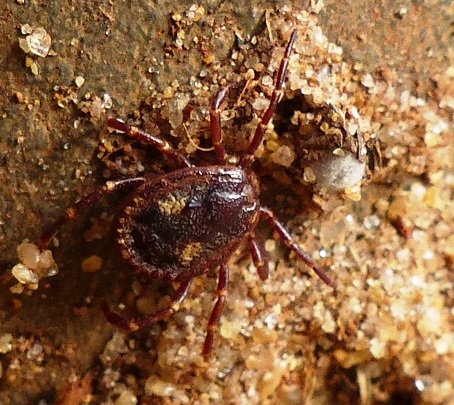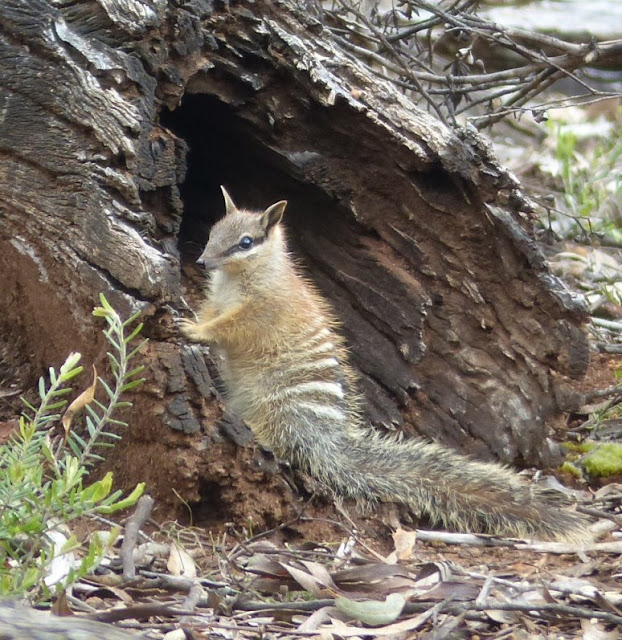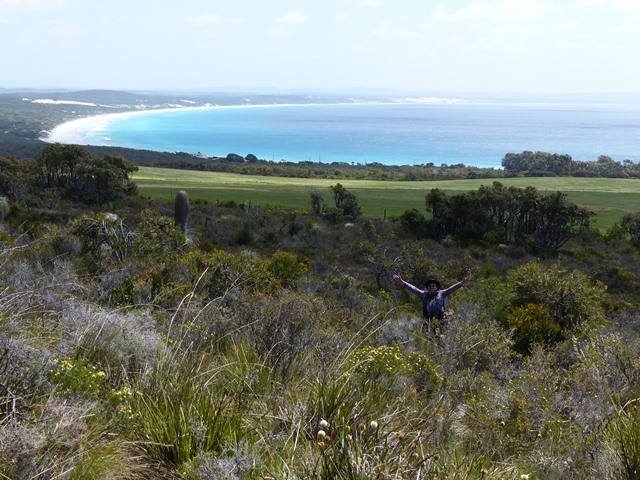18 October to 3 November 2017
By Gloria Seow travelling with Timothy Pwee
Western Australia (WA) is the largest state in Australia. We covered the southwest portion, including Perth, Rottnest Island, Dryandra, Cheynes Beach, Stirling Ranges and Margaret River. We were fortunate to reap a gratifying harvest of sightings, including highlights such as: memorable run-ins with the cutesy Numbat (animal emblem of WA), selfies with 'the world's happiest animal' the Quokka, watching an Emu family up close, and even a scary encounter with a serpent. Large swathes of the countryside were carpeted in an astonishing array of wildflowers, a glorious celebration of springtime. In total, we saw 101 bird species (51 lifers) and 24 species of mammals, reptiles and amphibians of which 21 were lifers. Please see trip list at the end of this post.
Our palates were satiated with hearty food at every turn, including kangaroo steak and fine dining framed by the blue skies and vineyards of Margaret River. Poking around Perth's hoods south-of-river (Swan River), we were pleased to find cuisines spanning Singaporean/Malaysian, Filipino, Vietnamese, Chinese, Indian, Myanmese, Middle-eastern and South African, a testimony to the diversity of the populace. After our WA leg, we flew to Bangkok to catch the Loy Krathong festival and indulge in Thai food, massage and shopping.
Our first foray in Perth took us to King's Park and Botanic Gardens. This was just up the street from our service apartment where we were based for five nights. We had an enticing introduction to the splash of hues that characterise wildflower season, a foretaste of the days ahead. At 400 hectares, King's Park is one of the world's biggest city parks, boasting untamed bushland and manicured landscaping. From its higher elevations, vistas of the Swan and Canning Rivers, the city skyline and Darling Ranges can be had.
Zesty outdoor shopping in downtown Perth.
Freshwater Crayfish, found at a dam in John Forrest. I have narrowed its ID down to the endemic Gilgie (Cherax quinquecarinatus), the native Marron (Cherax cainii) or the invasive Common Yabby (Cherax destructor). To my untrained eye, the three edible Cherax species are too similar to tell apart. Interestingly, the Common Yabby is known to walk 60 km overland in search of new water bodies. Imagine meeting a Yabby clacking down a forest trail!
The bustle at Fremantle Harbour and Market is palpable, where local produce, craft and prepared food stalls attract a steady stream of locals and tourists alike. We sampled Greek and Australian breakfast fare, washed down with latte in a relaxed al fresco setting.
Since we had a kitchen in our studio, we made breakfast on some mornings. Tim's kangaroo patties and eggs went well with toast, salad and chunks of cheese.
Swan Valley is just a half-hour drive from town and is replete with vineyards and artisanal chow. We were drawn to its chocolates, wine, gourmet coffee beans, honey, cheeses, nougats and fresh produce, opening our wallets at each of these stops. It was almost festive at The Margaret River Chocolate Company where I was mildly shocked to see parents scooping heaps of chocolate pastilles (free tasting) onto the palms of kids. They even went back for seconds. We had breakfast at its cafe, followed by chocolate pralines and truffles. We left lugging an obscene amount of chocolates and fudges as gifts for family and colleagues. The Margaret River Providore next door was also a taster paradise. We sampled fine preserves, chutneys, wine and chocolate liqueur, buying a bottle of Apple Balsamic Vinegar in return.
We randomly chose Lancaster Wines to stop at, one of the area's many vineyards. They were generous with their complimentary wine tasting paired with cheeses. We departed with a bottle of Rosé.
Alfred's Kitchen in East Guildford served up this delectable stacked bun. We could see why it was one of Perth's famous hamburger joints. We wolfed down our meal at its diner, a refurbished train car overlooking a suburban playground.
Tim's friend Kim took us on a tour of his former workplace at Murdoch University. Thereafter, we had coffee at a garden cafe in Riverton with the Canning River as backdrop. Bucolic Black Swans (the bird emblem of Perth) and other avian paddlers were readily seen.
The Rottnest Express Ferry was our opportunity to cruise down the Swan River en route to Rottnest Island (or simply 'Rotto' to locals). We caught the 8 am ride from Barrack Street Jetty situated next to The Bell Tower. The Bell Tower is one of the most architecturally distinct buildings in the CBD, standing out for its curves and bells from the 14th century. As a real estate aficionado, I enjoyed looking at the numerous swanky abodes and yachts lining the Swan River, particularly those along Millionaire’s Row. The ferry service had the occasional commentary to point out the famous homes and dish out local gossip. While taking in the sights, I was also on the lookout for wildlife. We passed islets where water birds congregated. My best find was a glimpse of a lone Dolphin in the river at close range. It only surfaced once, making it difficult to pinpoint its ID. Ever hopeful of seeing the Great White or even the Orca during the sea crossing to Rotto (both were possibilities), Tim also joined in the watch but we had no luck there.
I was pleased to discover that Rottnest had a good seafront restaurant serving cerviche. We also had meals at Dome coffee chain.
The King's Skink (Egernia kingii) is a massive brute of a lizard measuring half a metre long and is common on Rottnest. I was taken aback at its size when I first saw it, on the open deck of the seafront restaurant we were at. Clearly, some were habituated to the presence of humans. Melanistic skinks (see photo) are not as common as brown ones. Like geckos, the skink has a detachable tail that can serve as a decoy to escape would-be predators.
We were excited to meet the 'happiest animal on earth', the irresistible Quokka (Setonix brachyurus). Here on Rotto, this wallaby (amongst the smallest) can become instant friends with humans. This has resulted in must-have selfies that have made the Quokka a social media sensation. Incidentally, the Quokka is responsible for the island's name. In 1696, visiting Dutchman Willem de Vlamingh mistook it for giant rats, naming it "Rotte nest" or "rat nest" in Dutch.
This Quokka took an interest in Tim's rucksack, slipping his adorable little head into the half-opened zipper. Tim managed to get it to drink from his outstretched palm. Like the Kangaroo, the Quokka is able to grasp leaves with one paw for feeding which I found remarkable. Despite being nocturnal, it is also active in the day. We had plenty of Quokkas feeding outside our chalet after dark, including mama and child pairs.
The mandatory Quokka selfie.

A pinstriped snail on a peppermint candy flower.
Pink Lake gets its slight pinkish hue from the beta carotene in the algae Dunaliella salina. Shrimps feeding on the algae also turn a light pink.
We peddled 22 km (round trip) to check out West End at the western tip of Rottnest. Sightings included the Western Osprey, the New Zealand Fur Seal and even distant pods of migrating Humpback Whales. We did not see any dolphins or sharks in the remote bays along the coastal route. Out here, the Quokkas were few and far between, and more skittish than those in town.
We made a detour to Cathedral Rocks to see the curious sight of New Zealand Fur Seals (Arctocephalus forsteri) dozing and drifting in the placid waters. Their limbs were held aloft in a sort of comical water ballet pose. Apparently, this is how the colony of 80 individuals thermo-regulate. NZ fur seals have external ear flaps and a pointy snout. We found a few basking, while others were jostling each other on a rocky outcrop. Big bulls reach 180 kg / 2.5 m body length. Fur seals hunt at night for squid, octopus, fish, and the occasional seabird including penguins. In turn, they have to watch out for sharks, orcas and sea lions.
I got too close to the Kangaroos (feeding them strawberries and taking selfies) and picked up a Kangaroo Tick on my body. Luckily, I evicted it before it could bite. A passing ranger confirmed Tim's ID that it was a tick and not a spider.
Most Outback lodgings required us to bring sleeping bags (bed sheets not provided), as well as clean the sink and floor before checking out. This hour-long task imposed on guests was likely due to labour and/or water shortage. We managed to secure the last room at Lions Dryandra Woodland Village for one night (could prepare our own meals) and had to settle for a hotel in Narrogin town the next night (30 km drive, but with a nice restaurant).
There are four species of Echidnas worldwide: one in Australia and the rest in Papua New Guinea. Together with the Platypus, they are the only mammals (Monotreme) that lay eggs like birds. In the case of the Short-beaked Echidna, one young is raised in its mother's pouch till 7 weeks old when it becomes too spiky for comfort. It progresses to living in an underground burrow with mum. At six months, it graduates to a solitary lifestyle. Five subspecies of Short-beaked Echidnas are found in Australia. They feed on ants and termites and can swim. If attacked, they curl into spiny balls. This was our first Monotreme sighting, after missing the Platypus in Tasmania.
If it were up to me, this Dryandra oddity would be called the Vermicelli Flower.
The antics of the Woylie / Brush-tailed Bettong (Bettongia penicillata) tickled us pink. Two of them were so disorientated by our headlights that they hopped in a haphazard zig-zag fashion for a good 10 minutes. Unfortunately, my shot is blurry as my flash was not powerful enough to cover 50 m. We were also taken by the Wyolie's appearance, looking like a cross between a rat and a wallaby.
Another good find was the polka-dotted Western Quoll (Dasyurus geoffroii). A smallish mammal, it had an uncommon whitish eye shine compared to the usual orangey glows. Eye shine is caused by the reflection of light by the tapetum lucidum, helping nocturnal animals see better in the 'dark'. When discovered, the Western Quoll scuttled and escaped by scaling a tree.
We found an owl lifer here too - the Southern/Australian Boobook (Ninox boobook), the smallest and most common owl in Australia.
Our star find has got to be the rare Numbat / Banded Anteater (Myrmecobius fasciatus). As the animal emblem for WA, there are less than 1,000 in the wild, living in only two places in the Southwest. We were incredulously lucky to meet them twice. Our lifer run-in was at a forest trail in the Dryandra Woodland. It flashed across our path like a squirrel and ran into its hidey hole (see photo) inside a fallen log. We had to wait for 15 minutes about 30 m away, before it finally peeped out and re-emerged.
Our star find has got to be the rare Numbat / Banded Anteater (Myrmecobius fasciatus). As the animal emblem for WA, there are less than 1,000 in the wild, living in only two places in the Southwest. We were incredulously lucky to meet them twice. Our lifer run-in was at a forest trail in the Dryandra Woodland. It flashed across our path like a squirrel and ran into its hidey hole (see photo) inside a fallen log. We had to wait for 15 minutes about 30 m away, before it finally peeped out and re-emerged.
A few days later, we unexpectedly saw a second Numbat at the Jarrah woodlands in Tone State Forest (Perup Nature Reserve) near Manjimup, while driving on the logging trail. We took this route to get from Stirling Range National Park to Margaret River. This diurnal marsupial was running on the ground just ahead of our car. The lesson here is that one should drive slowly on the dirt tracks here.
The Numbat is a pouchless marsupial that shelters in hollow logs, trees and burrows. It hunts alone for termites in the day. It cannot break into termite mounds but attacks when termites leave their nests and move underground to shallow feeding galleries. It then digs up the termites and uses its long sticky tongue to catch and consume 20,000 a day or 10% of its body weight. The Perth Zoo breeds them for reintroduction into protected habitats with fox control.
Dryandra wildflower
Dryandra dragonfly
The attractive Motorbike Frog (Ranoidea moorei) is named after the mating calls of male frogs. Sounding like a revving bike, this tree frog can be heard at night throughout the Southwest. They produce enormous 8 cm long tadpoles. We first saw them in a puddle under some bushes at Cheynes Beach.
We decided to do Cheynes Beach, a recommended birding site for the Big Three endemic skulkers of the Southwest: the Noisy Scrub-bird, Western Bristlebird and Western Whipbird. Despite several long stake-outs of the Noisy Scrub-bird (including with visiting birders), we dipped it. The other two endemics were also no shows. Perhaps the unrelenting sea breeze blowing day and night had a part to play for the site's dismal showing. Nevertheless, Cheynes Beach was Wildflower Central for us. Spectacularly carpeted and lightly fragranced, we enjoyed stooping low to capture shots of the coastal blossoms.

Spiky and hairy flora at Cheynes Beach.
This stupendous 10 cm big beetle had a striking tiger-like underside. It was clambering on a bush with some difficulty due to the strong breezes.
Banksia with velvety leaves.
We saw several specimens of the terrestrial Cowslip Orchid (Caladenia flava).
This shaggy plant brought to mind the candy-coloured Trufulla trees in Dr Seuss's book 'The Lorax'.
An overview of the wildflower and birding site of Cheynes Beach.
Tightly-clustered florets in a vertical arrangement.
I believe this is the Marri (Corymbia calophylla) tree, a fast-growing coloniser of disturbed areas. Its gumnut fruits produce big seeds favoured by birds. Allied to the bloodwoods, its trunk will exude a blood red gum if attacked by insects.
Fine florets form a natural bouquet.
Cheery flowers with bulbous leaves growing readily on beach sand.
The New Holland Honeyeater (Phylidonyris novaehollandiae) is a visible bird at Cheynes Beach.
The Southwest has many Banksia species and I was constantly amazed at how varied they looked, even within a plant.
A Banksia with a popsicle seed pod.
This bloom closely resembles the Manuka flower.
A close-up look at the colour palette of the Common Bronzewing (Phaps chalcoptera).
The Galah / Pink and Grey Cockatoo (Eolophus roseicapilla) is widespread in Australia.
Yellow-rumped Thornbill (Acanthiza chrysorrhoa), a petite and hyperactive insect feeder was nesting at the Cheynes Beach Caravan Park.
While driving to our next destination, we stopped to look at a raptor. Our car was parked next to a roadside stream where Tim serendipitously noticed a 1 cm frog. Peering closely, we realised that there were many of these miniscule frogs hidden amongst the pebbles. No wonder at our first night herping at John Forrest National Park, we heard tonnes of calling frogs but drew a blank at sightings.
This is our prettiest Banksia, clothed in Christmas candy cane colours. We found it at Two People's Bay National Park.
Two People's Bay National Park was our attempt at spotting migrating whales, Great Whites, and the Noisy Scrubbird. None of these targets materialised but the dramatic view was worth the pitstop.
We popped into the town of Albany for lunch and groceries. This is a major stop for the campervan crowd to do whale watching and astronomy tours.
The greasy result of messing around the kitchen. It paired nicely with chutney bought from Swan Valley and some salad.
Ethereal florets reminiscent of weddings.
Camouflaged and giant 10 cm long tadpoles.
Motorbike Frog (Ranoidea moorei) found behind our hotel in Stirling Range National Park. A noisy population thrived inside the water tanks and holding ponds.
Thorny leaves encircle a spiny bloom.




































































































































